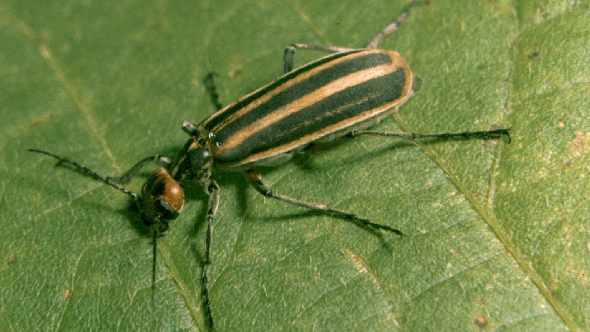Don’t Turn Your Back On Striped Blister Beetles
Crops Affected
The striped blister beetle (Epicauta vittata Fabricius) is one of the most damaging of the blister beetles to a wide range of vegetable crops (bean, beet, carrot, cabbage, Chinese cabbage, corn, eggplant, melon, mustard, pea, pepper, potato, radish, spinach, squash, sweet potato, and tomato). Pigweed is highly preferred by adults.

Photo courtesy of Clemson University
Identification
The striped blister beetle is native to much of the eastern U.S. and Canada. Populations from the southeastern coastal plain, including Florida, differ in appearance from beetles found in other parts of the country.
It is relatively large in size and has a voracious appetite. They have a tendency to aggregate into large mating and feeding swarms. Having a high degree of dispersiveness can result in sudden appearance of large swarms of beetles and damage to crops.
Blister beetles contain a substance called cantharidin, which causes blisters to form on the skin of sensitive humans who come into contact with crushed beetles, and in formation of blisters in the mouths of livestock, particularly horses.
The adults are ½ inch to ¾ inch in length and are black and yellow in color. The adult is elongate and slender in form. The thorax is narrower than the head and abdomen, and the legs and antennae are moderately long. The color pattern varies geographically. Northern populations often bear only two black stripes on the elytra whereas southern populations usually bear three black stripes.
The larva has long legs and is quite mobile. Newly hatched larvae soon turn reddish brown with dark brown bands on the thorax and abdomen. The larvae are predaceous and feed on the eggs of grasshoppers.
The pupa is found in the soil and resembles the adult in form, though the wings and legs are tightly drawn to the ventral surface.
Survival And Spread
In Florida and more southern states, there are two generations per year. The generations overlap and in warmer areas, adults can be found during April through October.
The adults are most active during the morning and late afternoon, seeking shelter from the sun at mid-day. These pests are easily disturbed, dropping readily from the plant and hiding if threatened.
The eggs of striped blister beetles are whitish in color and are oval with rounded ends. The eggs are deposited in the soil within a tubular chamber in clusters of 100 to 200 eggs. The female covers the eggs after oviposition, and hatching occurs in 10 to 16 days.
The first instar disperse from the egg mass and locate grasshopper eggs on which they feed.
Management Methods
Blister beetle populations are easily controlled by foliar application of insecticides. The tendency of beetles to aggregate may result in serious defoliation in small areas of a field, and little or no damage elsewhere.
Careful scouting followed by spot treatment of infested areas may be able halt infestations.
Little is known concerning the natural enemies of striped blister beetle, but they are preyed on by some insects and birds.
Consult UF/IFAS recommendations for currently labeled insecticides for blister beetle control in vegetables.










